|
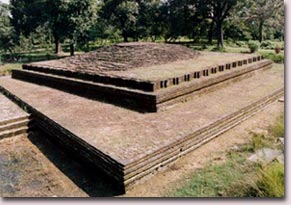 |
Nirvana
Stupa
This huge brickwork stupa,
exposed by Carlleyl in 1867, stands at a height of 2.74 meter. A copper
vessel was unearthed at this site. It bore an inscription in ancient
Brahmi, which stated that Lord Buddha's remains had been deposited
here. The Stupa is located in the east of the main Nirvana
Temple.
Visiting Hours : Sunrise to Sunset |
Nirvana Temple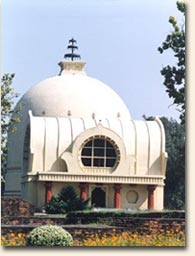
This houses the over 6 meters long statue of reclining
Buddha. The image was uearthed during the excavations of 1876. Carved
from Chunar sandstone, the statue represents the dying Buddha reclining
on his right side. An inscription below dates the statue to the fifth
century AD.
The temple stands on the same plinth as the Stupa behind it. As
mentioned above the ruins of this temple and the reclining Nirvana
statue inside were discovered by Carlleyl in 1876. By sinking a
vertical trench at the centre of its mound he first discovered the great
statue in a much-shattered condition lying on a broken pedestal. Many of
its broken parts were then missing and it appeared that it had once in
the past been repaired with plaster. In his search for the missing parts
he found many of them buried in the core of the pedestal itself. With
their help he restored and repaired the statue and the pedestal almost to
their original forms and shapes, though some of the broken fragments of
the statue were still wanting. The statue measures 6.1 m in length and
is executed out of one block of sandstone of mixed reddish colour
probably from Chunar. It represents the Dying Buddha reclining on his
right side with his face turned towards the west. It is placed on large
brick pedestal with stone posts at the corners and once faced with stone
slabs on all the sides. The western side of the pedestal facing the
entrance, however, bears sculptures representing three human figures,
each carved in a shallow niche cut into a solid block of stone. The
figure to the extreme left represents a female in mourning with
disheveled long hair and crouching forward in grief with her hands
resting on the ground. The figure to the extreme right is indistinct but
may represent a male or female, also in grief, as indicated by the head
resting on the right hand. The central figure represents a man sitting
cross-legged with the back turned towards the spectator. Right below him
is an inscription datable to the fifth century A.D., recording that the
statue was 'the appropriate religious gift of the Mahavihara-svamin
Haribala' and that 'it was fashioned by Din. 'It is difficult to
identify the personalities of the three mourners, though the central
figure may be presumed to be that of the donor Haribala himself. After
the clearance of the debris around the statue, Carlleyle found the
shrine-chamber to be oblong on plan with an oblong antechamber in front
towards its west. The thickness of the walls of the chamber was nearly
3.05 m, its interior measuring 9.35 m in length and 3.66 m in width,
leaving a space of hardly 0.61 m to move around the pedestal. The walls
were very badly shattered showing only one entrance facing west. The
antechamber measured internally 10.92 m in length and 4.57 m in width
with an entrance facing west, its walls being 1.22 m in thickness. In
the course of clearance Carlleyle found numerous bricks with slightly
smooth and curved surface, which led him to believe that the temple once
had a roof with arched vault with a pointed end.
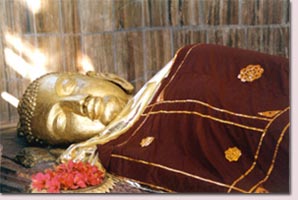
The ruins and debris
further indicated to him that there had originally existed an
entrance-doorway facing west and a window in each of the northern and
southern side-walls of the shrine-chamber as well as of the antechamber
and consisted of arched vaults. Proceeding on these assumptions he
completely restored the temple in 1876. There is no doubt that the
temple so hypothetically restored by Carlleyle did not essentially
conform to the one in which the great statue had originally been
installed in the fifth century A.D. From the evidence of the later
plaster repairs to the statue, it is likely that the original temple
might also have undergone changes in the succeeding centuries. There
were, besides, traces of a larger and definite earlier temple with
recessed corners close to the northern and southern walls of the present
one, indicating that a large temple enshrining the statue had existed on
the spot before the construction of the temple restored by Carlleyl. It
is, however, difficult to say whether this earlier temple was the same
in which the statue had originally been installed and which was seen by
Hiuen Tsang .The temple discovered and restored by Carlleyl
must have belonged to a much later period representing the expiring days
of Buddhism, possibly even later than the eleventh or twelfth century,
as would be obvious from its clumsy architectural features having no
parallel in any Buddhist sanctuary in India. In May 1955, a committee
was appointed by the Government of India for the improvement of the
sites connected with the life of Buddha for the ensuing 2500th Buddha
Jayanti celebrations. On the representation of the Buddhists the
committee considered it absolutely necessary to remove the restored
structure entirely, as it offered practically no space for the pilgrims
to circumambulate the statue and made the interior entirely suffocating,
and proposed to build a new structure suitably designed in conformity
with the character and importance of the monument. As a result thereof
the present temple was constructed in 1956.
The Western Group
Ranged around the Stupa and the Nirvana temple are to be seen a number of brick
structures which were raised from time to time as complements to the
nucleus formed by the most sacred monument. Close to the entrance of the
temple, to the north-west, one sees some structural ruins at a level
much lower than that of the long array of buildings to the west. They
represent the ruins of two monasteries, somewhat alike on plan and
erected side by side. In the excavation were found a number of inscribed
and datable objects, including a clay seal with the presentation of the
coffin of Buddha in between two sal trees and the legend of Parinirvana
and bhikshu-sangha in two lines, two other seals with a similar legend
and a clay tablet with the figure of standing Maitreya and the
well-known Buddhist formula. All the legends were in a script assignable
to the fourth century .A silver coin (perhaps of a Satrap of western
India, Damasena) was also found here, as also some broken terracotta
figures and a good amount of pottery including a clay censer with
crocodile mouth. It appears from the evidence of these finds and the
deep level at which they were found that both the monasteries were built
earlier than the fourth century. To the west, in front of the temple, is
seen a very large block of buildings covering a length of 109.73 m. of
them, the one to the north measures 45.72 m square externally. It
represents the largest monastery so far discovered at the place and
comprises, in fact, not one but two monasteries of different periods and
constructions, the latter being built on the ruins and foundations of
the earlier one with some additions and alterations. The earlier
monastery is indicated by the brickwork at the lower levels and
consisted of a large open court paved with bricks with a still-existing
circular well in its northern portion. It was enclosed by corridors
about 3.05 m wide on all its four sides, which, in turn, were surrounded
by rows of small cells of slightly varying sizes for the residence of
monks. The cells and the corridors had concrete floors. The monastery
faced east and was accessible through an entrance flanked by a
projecting turret on each side and was floored with concrete. The walls
were very massive and thick, indicating a possibility that the building
had several stories. During excavation were found an inscribed clay
seal, datable to about A.D. 900 in the well and a number of similar
seals in the debris covering the courtyard. This indicated that the
building had been constructed in about the eighth century and deserted
some time after A.D. 900. A century or so later, a new but much inferior
construction was raised on the ruined foundations of the older monastery
by leveling down the debris and thus raising its floor-level by nearly
18.3 m. While doing this, the builders freely used carved bricks and
materials from the ruins of the older structures; they are seen here and
there in the later wall. The later monastery was almost identical on
plan with the earlier one. It appears, however, that the
entrance-chamber formed by the two flanking turrets of the earlier
monastery was filled up to the maximum height of nearly 2.74 m with an
eastward slope to offer a sloping entrance to the later monastery with a
higher floor-level. As compared with the existing ruins of the earlier
monastery, much less now remains of the later construction, as obviously
its bricks had been quarried away by the neighbouring villagers. Along
the southern wall of this monastery are seen other similar buildings
forming a compact block of four structures representing four separate
but interconnected monasteries differing on plan and in dimensions. Of
them, the north-eastern building is situated exactly opposite the
Nirvana temple in front, its orientation being slightly oblique to the
alignment of the central monuments. It consists of a square open court,
with a circular well at the centre, surrounded possibly by a covered
verandah in front of the rows of cells on all the four sides. To the
west of this building is another structure, consisting of a similar open
court with a rectangular tank at its centre but with cells or rooms only
on its northern and western sides. In the course of the excavation of
these two structures, inscribed clay seals datable to the Gupta age
(fourth-fifth century) were found along with metal vessels and other
objects on their floors and in the well referred to. These monasteries
therefore belonged to some earlier period. Of the other two buildings in
this block, the one at the centre is also a monastery consisting of a
rectangular court with corridors on its east, north and west and a row
of rooms further east and west. The building adjoining it further south
is a much larger one, 33.53 m square in dimensions, with an open court
enclosed by corridors and rows of five cells of varying dimensions on
each of all the four sides. Its rooms had concrete floors, while its
open court was paved with bricks. It has its entrance facing east. The
building once bore a flat-terraced roof. In the course of excavation a
number of inscribed and datable objects, including a gold coin of
Chandragupta II (fourth-fifth century A.D., were found. In one of the
rooms a very fragmentary inscription of Kushana age (first century A.D.)
was recovered, while in the courtyard were discovered numerous pieces of
an image in the red sandstone of the Mathura region, representing a
standing figure of Buddha, with an inscription of about the fifth
century on its pedestal referring to the fact that it was executed by
one Dinna of Mathura.1 Thus, all the four monasteries in this block were
erected in the first century and were destroyed some time about A.D. 600
The Southern Group
The monuments in this group represent mostly
small-sized stupas raised from time to time by devoted pilgrims in token
of their pious visits to the holy monuments. It appears that the
monuments were enclosed on the south by a wall proceeding from a
considerable length. At the centre of this group , two stupas stand out
rather prominently because of the carved brickwork and ornamental
pilasters and cornices of their basements, which resemble closely the
earlier plinth of the Main Stupa and may, therefore, belong to an
earlier date. Further, there is an interesting oblong structure to the
north of them . There is reference to a person with a similar name in the
inscription on the pedestal of the Nirvana statue of the same period .
It is likely that the same person is referred to in both the records.
touching, or partly concealed by, the plinth of the main monument.
Inside it is a block of solid brickwork oblong on plan and resembling a
coffin or grave. It is not in alignment with the plinth and would appear
to be a much earlier building. It faces west with an entrance 1.57 m
wide, on both sides of which, at the corners, were once placed
terracotta images of Buddha in meditation. The large structure in the
eastern portion of this group belongs to the expiring days of Buddhism
at Kusinagar, as is obvious from its crude construction in which bricks
of various sizes, collected from the earlier ruins, were freely used.
The Eastern Group
The most important and interesting of the ruins in the
eastern group is the large platform-like brick structure , a little
obliquely orientated towards the main monument. As it is seen now, it
consists of two terraces, the lower one being square with a flight of
steps giving access to it at its north-western end. The second or upper
terrace is smaller, thus leaving a margin of about 3.66 m for a
brick-paved procession-path all around it. The path is, however, not
uniformly wide on all sides, since the sides of both the terraces are
not quite parallel. While the walls of the lower terrace are plain
except for the decorative brick mouldings and string-courses, the walls
of the upper terrace once bore a number of decorative mouldings and
cornices together with a continuous row of ornamental pilasters, traces
of some of which are still visible on the structure. There was perhaps a
third and smaller terrace above, but it no longer exists. What sacred
monument is represented by this quaint building it is difficult to say,
but it may have been surmounted by a stupa of an uncommon type. There is
nothing to show that a temple stood at the top, though an image of
Ganesa, apparently imported, was found in the ruins, Since there is no
mention of any such structure by Hiuen Tsang, it may be assigned to a
date later than the seventh century A. D. Against the north-western
corner of this terraced building was discovered a small structure built
of large-sized bricks, the largest to be found at the place (48'26 x
25'4x 7'62cm and 46'20 x 25'4 x 6'99 cm) resembling bricks commonly
assigned to the Mauryan age. The walls exist only in three courses of
bricks with a thickness of 48'26 cm, The structure represents a small
chamber, 2' 54 x 2'92 m, and its eastern wall appears to go further
northwards. In the corner formed by this projecting wall copper coins,
eight of Kanishka and four of Kadphises II, were found mixed with
charred substance, indicating that this building had been destroyed in
the Kushana period. From the facts that its orientation is different
from that of the main monument and that it stands at a lower level, its
higher antiquity is obvious. It may have formed part of a much larger
building which has either disappeared or is concealed under the plinth
of the main monument close by. Along the eastern side of the plinth of
the main monument are also to be seen a few small-sized stupas partly
concealed in the plinth. They are obviously earlier in date and are
related to an earlier central monument later encased by the plinth of
the Main Stupa.
The Northern Group
To the north of this small building,
which may be assigned to the Mauryan age, are seen a number of small
stupas raised by pilgrims like those in the southern group. To their
west, at a lower level, are seen the ruins of two square-shaped
structures representing some early shrines, with a later wall crossing
over them running from north to south and meeting the plinth of the Main
Stupa. Much overlapping of constructional activities might have taken
place here from very early times, possibly the Mauryan period, down to
the tenth century. In the area further west, some of the walls contain
bricks of very large sizes usually ascribed to the Mauryan age. Similar
large bricks were found in the same area in the course of deep digging,
though the structures to which they belonged had already disappeared.
The digging further yielded an interesting terracotta female figurine of
perhaps the first century A. D. and a fragmentary stone inscription of
the fifth century A. D. Further northwards are situated the ruins of an
array of buildings much in the same manner as the row of the western
monasteries ranged in front of the Nirvana temple. They, however, face
south towards the central monument and represent two separate
monasteries, of which the western one consists of a central open space
occupied by a square tank enclosed by a dwarf-wall and floored with
bricks. On all sides of the tank are verandahs with the monastic cells
facing them. Towards the south are traces of two projecting rooms
flanking the entrance. The eastern building has not been excavated
completely, but it may also be found to consist of the same plan as that
of the other neighbouring monasteries. Some inscribed seals, found in
the excavation of the central monastery, may place this group of
monasteries in about the ninth or tenth century A. D. In the extreme
eastern portion of the Main Site are seen the ruins of an isolated
building, which, strangely enough, faces east, as indicated by the two
projections flanking its entrance on that side, and not towards the Main
Stupa. Unlike the other monasteries, it had no central open space or
courtyard but had instead a large detached hall, 9.14 m square, with an
entrance facing north and with two windows on each of the other sides.
The narrow space all around it was perhaps an open passage facing the
monastic cells on the other side. The purpose of this hall is not clear;
perhaps it represents the sabbath-hall or posathagara, i.e. a place
where the weekly assembly of the monks took place for mutual
edification. Only a few finds came to light in the excavation of this
buildings; of them, only one clay tablet, inscribed with the usual
Buddhist creed, is worth noting. The monastery is datable to a late
period, i.e. the tenth or eleventh century A. D.
Visiting Hours :
Sunrise to Sunset
Mathakuar Shrine
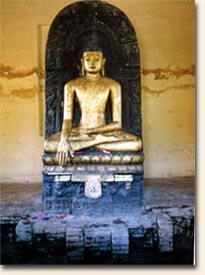
This Shrine lies about 400 yards form the
Parinirvana stupa. A black stone image of the Buddha in the bhumi
sparsha mudra was recovered here. The last sermon by Lord Buddha was
given here.
More than a furlong south-west of the Main Site, by the side of the
road, is the Matha-kuar shrine, wherein is installed a colossal statue
of Buddha, locally called Matha-kuar. The possible significance of its
name has already been referred to. The statue measures 3.05 m in height
and is carved out of one block of the blue stone of the Gaya region to
represent Buddha seated under the Bodhi tree in a pose known as the
bhumisparsa-mudra ('earth-touching attitude'), which symbolically
expresses the supreme moment in Buddha's life just before his
Enlightenment, when he called upon the Earth to bear witness to the
pieties performed by him in his previous births. On the base of the
statue is an inscription, much effaced and thus not completely readable
but otherwise datable to the tenth or eleventh century .The statue was
found broken into two pieces and was repaired and restored to its
original position in the chapel and the existing temple built to shelter
it in 1927 out of the contributions made by the donors referred to above
In 1876, Carlleyle exposed the shrine to which the statue belonged.
However, in later excavations it was found that the shrine was not an
independent structure but formed part of much larger building,
representing a monastery which measured 34'75 m externally. The
monastery consisted of a central open court, 13.41 m square, surrounded
by corridors, 2.59 m wide, on all the four sides, which, in turn, faced
the usual rows of rooms. The building faced east. In its western flank
the central room projected a little wall, since it was meant to be the
chapel of the monastery in which the statue was installed on an
elaborate brick pedestal. The chapel was once surrounded by a
procession-path which detached it from the neighbouring rooms. The
excavation here did not yield any important antiquities. Some clay seals
bearing the usual Buddhist formula, of about the tenth or eleventh
century, were, however, discovered along with other minor objects. But a
stone inscription datable to the same period had been found here by
Carlleyle; it may have recorded the fact of the construction of the
monastery and the chapel attached to it in the reign of a local chief of
the Kalachuri dynasty, probably Bhimata II. It has been established by
partial excavation that this monastery formed part of a large group of
subsidiary monuments which once surrounded the Main Stupa and the
Nirvana temple, as is evident from the traces of an extensive wall
running all round this group. his wall, now totally concealed below the
surrounding fields, was roughly constructed of broken brickbats
enclosing a space of nearly 14.5687 hectares in the shape of a rhombus
with practically equal sides, each measuring about 381 m in length, and
with an entrance, 3.61 m wide, pierced in the eastern half of the
southern.
The inscription has been published in V. V. Mirashi, Inscriptions of
the Chedi-Kalachuri Era, pt. ii, Corpus Inscriptionum Indicarum, IV (Ootacamund,
1955), pp. 375 ff. wall, not far from the south-eastern corner. Since no
such entrance was traceable on the other sides, it is likely that the
main approach to the group of monuments inside the enclosure was through
this gate. As less than a third of the area has so far been excavated,
it is likely that some more monuments lie concealed below the ground of
the remaining area inside the enclosure. The position of the wall will
be clear from the illustration on p. 17.
Visiting Hours : Sunrise to
Sunset
Ramabhar Stupa
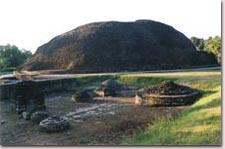 About 1 km away, this large stupa rises to a height of
49 ft. It marks the site where the Lord Buddha was cremated. In ancient
Buddhist texts this stupa has been referred to as Mukut-Bandhan Vihar.
Alias THE CREMATION STUPA Less than 1.61 km to the east of the
Matha-kuar shrine stands a mound facing the road from Kasia to Deoria.
There is a sheet of water, called Ramabhar Jhil or pond, close to it,
which dries up in summer. Whether the name Ramabhar originally belonged
to the pond or to the mound it is difficult to say; nor can it be
satisfactorily derived or its relation to the events of Buddha's death
easily explained. Its location in relation to the other monuments at
Kusinagara and the peculiar character of the monument it represents,
however, clearly goes to prove that it is the site of the Cremation Stupa
or the Mukutabandhanachaitya of Buddhist tradition . About 1 km away, this large stupa rises to a height of
49 ft. It marks the site where the Lord Buddha was cremated. In ancient
Buddhist texts this stupa has been referred to as Mukut-Bandhan Vihar.
Alias THE CREMATION STUPA Less than 1.61 km to the east of the
Matha-kuar shrine stands a mound facing the road from Kasia to Deoria.
There is a sheet of water, called Ramabhar Jhil or pond, close to it,
which dries up in summer. Whether the name Ramabhar originally belonged
to the pond or to the mound it is difficult to say; nor can it be
satisfactorily derived or its relation to the events of Buddha's death
easily explained. Its location in relation to the other monuments at
Kusinagara and the peculiar character of the monument it represents,
however, clearly goes to prove that it is the site of the Cremation Stupa
or the Mukutabandhanachaitya of Buddhist tradition .
About a hundred years back, the mound attracted the attention of a
civil officer, who did some digging at its top, but what he found is not
known. Cunningham also tried to dig it but left the attempt. In 1910,
another attempt was made by Hirananda Shastri, who, by sinking a shaft
at its centre, went down to 1.52 m below the water-Ievel and found a
brick flooring and corners of walls; but they indicated nothing about
the real character of the buildings to which they belonged. He then
exposed part of the eastern face of the mound and discovered that it
represented an unusually large stupa with a huge circular drum, 34.14 m
in diameter, resting on a circular plinth, consisting of two or more
terraces, and 47.24 m in diameter at the base. In the point of
dimensions the stupa appears to have been double the size of the Main
Stupa of the Main Site. Hundreds of clay seals, with the usual Buddhist
formulae inscribed on them in medieval characters, were found in the
excavation. From the various sizes of bricks of its much-disturbed
construction and from some structural traces discovered underneath its
basement, it is evident that this monument had seen changes by repairs
and renovations. During the year 1956, the entire basement of the stupa
was exposed, in the course of which also similar seals were found. There
seems to be no doubt that, like the Main Stupa, this monument also
claimed great sancticy and was likewise surrounded by subsidiary
monuments, such as minor stupas or shrines, partly revealed in the
excavation of a small portion of the area close to its south-east.
Touching its basement was found a building of large bricks, representing
an expansive rectangular hall of uncertain purpose and resting on a
plinth built of smaller bricks. The other excavated ruins represented
the usual minor stupas raised by pilgrims from time to time. It is
further obvious that this colossal stupa conceals below itself earlier
structures, for, in A.D. 1911-12, when the lowest terrace of its
south-eastern basement was partly exposed, traces of such structures, of
an uncertain nature, were encountered. The most interesting but uncommon
finds in the excavation of this monument were ornamental bricks so
carved that if those of one set are joined together they make the
carving of a human figure or other figures of sorts. The bricks were
also provided with holes pierced through them, perhaps for facility of
quick firing and effective baking in the kiln.
Visiting Hours : Sunrise
to Sunset
Japanese Temple
A beautiful Ashta Dhatu (eight
metlas) statue of Lord
Buddha, which came from Japan, can be seen here. Built by the Atago
Isshin 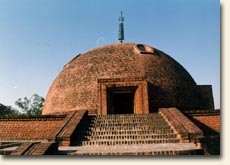 World Buddhist Cultural Association, it consists of a single
circular chamber, housing a golden image of Buddha, softly lit through
small, stained-glass window. World Buddhist Cultural Association, it consists of a single
circular chamber, housing a golden image of Buddha, softly lit through
small, stained-glass window.
Visiting Hours : Sunrise to Sunset
Kushinagar Museum
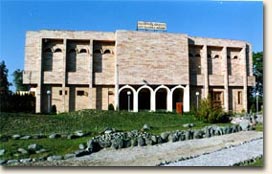 The Buddha Museum contains finds from excavations at the site.
The
museum has 248 precious antiques related to coins, statues and
sculptures, architectural remains & bronze statues. The Buddha Museum contains finds from excavations at the site.
The
museum has 248 precious antiques related to coins, statues and
sculptures, architectural remains & bronze statues.
The proposal was mooted to
found a museum for preserving the archaeological wealth from the region
and the present building came into existence in 1992-93. it is located
at about 1 km. Sough-East from the Kushinagar bus stop, ½ km. From the
Mahaparinirvana temple and about 3 Km. From the Kasia bus stand.
The nucleolus of the collection represents sculptures, terracottas
particularly the Buddhist icons, architectural remains, bronzes, clay
seals, banner paintings (Thankas) and a few coins. Besides , some Hindu
and Jaina antiquities are also on view. The Stucco statue of Lord Buddha
in the meditation posture is a superb specimen. It represents zenith of
the Gandhara School of Art. The beautifully decorated bricks excavated
from the region, also forms a part of the collection. The Museum is at
the developing stage and efforts are being made to collect the specimens
from different places and Institution. It also aims at co-ordinating
with other cultural, and educational organizations for disseminating
Indian and particularly Buddhist philosophy and culture.
Visiting Hours : 10: 00
. To 17:00
Weekly off: Monday.
Japanese
Garden
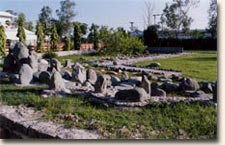
The Children park in the front of Buddha Museum is under
construction. The park is initially under Japanese eye of construction
and will be handed over to the UP Government on completion. The park can
be partially viewed as a rock garden.
Visiting Hours
: Sunrise to Sunset
Buddha Vihar
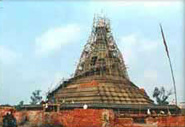 The Myanmar Buddha Vihar, first Monastry in Kushinagar, attracts the
tourist with many of its Buddhist temples inside their monastry. The
temples are equipped with beautiful metal statues of Lord
Buddha and a rare collection of Excavated Bone & Metals (Asthidhatu)
of Lords and followers. The Burmese Buddha Vihar also holds the main
charge for conducting Prayers in Mahaparinirvana Temple.
The Myanmar Buddha Vihar, first Monastry in Kushinagar, attracts the
tourist with many of its Buddhist temples inside their monastry. The
temples are equipped with beautiful metal statues of Lord
Buddha and a rare collection of Excavated Bone & Metals (Asthidhatu)
of Lords and followers. The Burmese Buddha Vihar also holds the main
charge for conducting Prayers in Mahaparinirvana Temple.
A huge "Samridhi
Chaitya" Stupa which will contain 5000 brass statues of Lord
Buddha from all over the World is under construction and is likely
to be inaugurated by 1st week of February 2001.
Wat Thai Temple
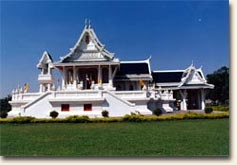
The one of its kind, this buddhist temple can be seen with
wide open eyes in Kushinagar.
The temple flourishes on its greenery well spread and pleasant
atmosphere. The beautiful Temple was designed to be the forest-
monastery gathering innumerable kinds of trees as to commemorate the
Golden Jubilee Celebrations of His Majesty King Bhumibol the Great's
Accession to the Throne. The construction of the temple is
compleated but the doors of the temple are likely to be opened by
2001 for general public.
Visiting Hours : Sunrise to Sunset
Chineese Temple
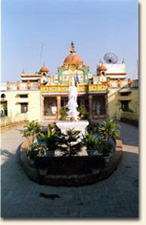 The Lin Sun Chinese Temple is the another attraction of Kushinagar, The
temple attracts the beautiful Chinese image of Lord Buddha. The
exterior looks of the temple gives a mix view of Chinese and Vietnamese architecture.
The temple also provides free stay facility to the Buddhist
tourists.
The Lin Sun Chinese Temple is the another attraction of Kushinagar, The
temple attracts the beautiful Chinese image of Lord Buddha. The
exterior looks of the temple gives a mix view of Chinese and Vietnamese architecture.
The temple also provides free stay facility to the Buddhist
tourists.
Visiting Hours : Sunrise to Sunset
Meditation
Park
 Recently developed near the
main Nirvana Temple, this park has artificial water bodies with
raised lush-green platforms for meditation srrounded by sal- trees
and other afforestations, representing a complete Buddhist-ambience. Recently developed near the
main Nirvana Temple, this park has artificial water bodies with
raised lush-green platforms for meditation srrounded by sal- trees
and other afforestations, representing a complete Buddhist-ambience.
Visiting Hours : Sunrise to Sunset
Birla Temple
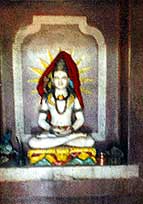 Birla
Hindu Temple, the shiva temple, is founded by Birla Group at the
nirvana site of Gautama Buddha. At the main site a marble statue of
lord Shiva sitting in an erect posture on tiger flash cushion. The
‘dhyana posture’ he is sitting in, is termed to be the position
in which the communion of thou soul (Jivatma) to thy soul (parmatma)
is possible. Birla
Hindu Temple, the shiva temple, is founded by Birla Group at the
nirvana site of Gautama Buddha. At the main site a marble statue of
lord Shiva sitting in an erect posture on tiger flash cushion. The
‘dhyana posture’ he is sitting in, is termed to be the position
in which the communion of thou soul (Jivatma) to thy soul (parmatma)
is possible.
The temple also provides accommodation for Hindu Buddhist
tourist on very nominal rates. A dormitory is also specially made for
Indian Buddhist tourists available at cheapest rates.
Visiting Hours : Sunrise to Sunset
International Buddha Trust
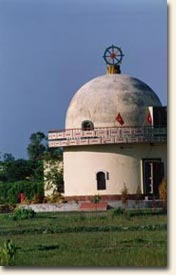 International Buddha
Trust started in
the
year 1996 with the motive to perform the
communion of the individual soul (Jivatman) with t he universal soul or
God (Parmatman). They believe that Yoga provides the perfect panacea
& is also a complete system of self-transformation & self realization which are
the ultimate goods of human existence. It acts as a bridge that unites
the ephemeral & limited Human body with the divine, internal,
infinite soul. The free classes are held for 10 days in a
year which includes free lodging and fooding too , each day providing new sense to the life style of every
individual . International Buddha
Trust started in
the
year 1996 with the motive to perform the
communion of the individual soul (Jivatman) with t he universal soul or
God (Parmatman). They believe that Yoga provides the perfect panacea
& is also a complete system of self-transformation & self realization which are
the ultimate goods of human existence. It acts as a bridge that unites
the ephemeral & limited Human body with the divine, internal,
infinite soul. The free classes are held for 10 days in a
year which includes free lodging and fooding too , each day providing new sense to the life style of every
individual .
Other places of interest
Pawanagar (Fazilnagar) , the Sun
Temple at Turkpatti, Japani Stupa, Kushawati Temple, Tibbatti
Temple and Korean Temple at Kushinagar.
|